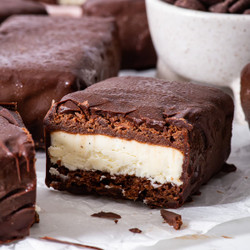Adjust the oven rack to the middle position, pre-heat the oven to 350ºF (180ºC) and line a 10x15-inch (25x38cm) rimmed baking sheet with parchment/baking paper. Lightly grease the parchment paper and the sides of the baking sheet with oil (you can also spray it with non-stick baking spray).Tip: Greasing the parchment paper ensures that the baked sponge will smoothly release from it without sticking.
In a heat-proof bowl, either in the microwave or above a pot of simmering water, melt the oil and chocolate together until the chocolate has fully melted. Set aside to cool until warm or lukewarm.
Using a stand mixer fitted with the whisk attachment or a hand mixer fitted with the double beaters, whisk the eggs and sugar together until pale, thick, fluffy and about tripled in volume (the ribbon stage). This should take about 5-7 minutes on a high speed setting.
Add the melted chocolate mixture, and whisk briefly until combined.
In a separate bowl, sift together the gluten free flour blend, cocoa powder, xanthan gum, baking powder and salt.
Add the dry ingredients to the chocolate-egg mixture and whisk well for about 15-30 seconds until no flour clumps remain. Scrape down the bottom and sides of the bowl to prevent any unmixed patches.
Transfer the batter into the lined baking sheet and smooth it out into an even layer (I recommend using a large offset spatula or a bench scraper for spreading and levelling out the batter). You can tap it a few times on the counter to make it perfectly level and also to get rid of any large trapped air pockets.Tip: It's very important that your batter is as level and even as you can get it, otherwise you'll get uneven layers in your ice cream sandwiches.
Bake at 350ºF (180ºC) for about 8-10 minutes or until well risen, soft and spongy to the touch, and an inserted toothpick comes out clean.
Allow the sponge to cool completely in the baking sheet.
In a large bowl, whip the cold heavy/double cream until you get firm (but not stiff) peaks.You can do this by hand using a large balloon whisk, with a stand mixer fitted with the whisk attachment or with a hand mixer fitted with the double beaters. If using a stand or a hand mixer, use the lowest speed setting to avoid over-whipping the cream.
Add the condensed milk and vanilla bean paste.
Whisk again until you get soft peaks.
Line an 8-inch (20cm) square baking tin with parchment/baking paper, aluminium foil or plastic wrap/cling film.Tip: The baking tin I used had a 7-inch (18cm) bottom, which made it the perfect fit for a sponge baked in a 10x15-inch (25x38cm) baking sheet. If your baking tin has straight edges and therefore an 8-inch (20cm) bottom the fit might be less perfect, but you'll trim the edges later on so it won't be a problem.
Turn the cooled sponge onto a large sheet of parchment/baking paper or onto your work surface, and peel away the top sheet of parchment/baking paper (that used to line the baking sheet).
Cut out two large sponge squares that fit the baking tin where you'll be assembling the ice cream sandwich slab.Tip: As I used a baking tin with a 7-inch (18cm) bottom, I cut out two 7-inch (18cm) squares of the chocolate sponge.
Place one of the sponge squares on the bottom of the lined baking tin.
Spread the no-churn ice cream mixture on top and smooth it out into an even layer (this is easiest done with a small offset spatula or a bench scraper).
Place the other sponge square on top, pressing down gently to adhere it to the ice cream mixture.
Cover the baking tin with plastic wrap/cling film or a sheet of aluminium foil and freeze for any least 6-8 hours or preferably overnight.
Once frozen solid, remove the ice cream sandwich slab from the baking tin and trim the edges with a large serrated knife. This will give you neater ice cream sandwiches.
Cut the frozen ice cream sandwich slab into the individual portions.I divided it into 8 rectangular slices (by cutting it in half in one direction and into quarters in the other direction), but you can also divide it into 16 smaller square portions.
Freeze the ice cream sandwiches again for about 30 minutes, while you prepare the melted chocolate for the chocolate shell.
Line a tray or baking sheet (that fits into your freezer!) with plastic wrap/cling film, parchment/baking paper or aluminium foil.
In a small or medium-sized bowl, melt the chocolate and coconut oil together until the chocolate has fully melted and the mixture is runny.Tip: Don't use a large bowl, as that will give you a shallow "pool" of melted chocolate. You want the melted chocolate mixture to be quite deep, so you can easily dip the ice cream sandwiches into it.
Dip the frozen ice cream sandwiches, one at a time, into the melted chocolate mixture. Make sure that all sides are covered in chocolate. Shake off as much excess chocolate as you can – you want to get a thin chocolate coating (a thick shell can be a bit too hard when you bite into it).Tip: I recommend using a fork to lift the ice cream sandwiches out of the melted chocolate. Then, tap the fork on the side of the bowl to shake off and remove as much excess chocolate as possible.
Transfer the chocolate-covered ice cream sandwiches onto the lined tray or baking sheet. As the ice cream sandwiches are very cold, the chocolate should set fairly quickly.
Freeze the chocolate-covered ice cream sandwiches for at least 1 hour before serving.
The gluten free ice cream sandwiches keep well in a closed air-tight container in the freezer for up to about 1 month.
